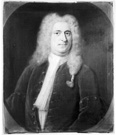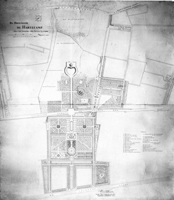
Clifford
| Who was George Clifford? | ||
| De Hartecamp |
 |
George Clifford was born in 1685 into a banker’s family, which originated from England. He had a great fascination for the natural world. On his country estate, De Hartecamp, he accumulated an internationally renowned living- and dried plant collection, living- and stuffed animals, and minerals. It is not known when Clifford first turned his collection into a herbarium. A large part of Clifford’s collections originated from the garden at De Hartekamp. Clifford was also part of a large, international network of people with a professional or amateur fascination in the natural world. | |
| Through the activities of other botanists working in Amsterdam and Leiden, such as Herman Boerhaave (1668-1738), Adriaan van Royen (1704-1779) and Johannes Burman (1707-1779) many exotic plants were added to Clifford’s collection. Moreover dried plants were exchanged as herbarium sheets. Collections from the period up until 1737, when Linnaeus’s Hortus Cliffortianus, was printed, reflect the enormous development that Dutch plant systematics underwent at this time both in terms of the theoretical understanding, with respect to the development of new systems for taxonomy, as well as practical insights resulting from the addition of further collections from all over the world. > back to the top > back |
||
De Hartecamp
De Hartecamp is an estate, located to the south of Heemstede, just outside Bennebroek. The name of this estate is derived from the name of one of the first owners, the Amsterdam merchant Hendrik Zeegersz. van de Camp, who adapted his surname to reflect the presence of deer (in Dutch ‘herten’) on his estate. The development of the garden at De Hartecamp began in 1693 when Johan Hinlopen bought the land, built a house and had it surrounded by a beautiful garden. At this stage in its history an orangerie was built, a place where tender garden plants could be overwintered. In 1709 George Clifford’s father, also George Clifford (1657-1727), bought the estate as a country mansion along with much of the surrounding land. In the period 1709-1788 this estate belonged to the Clifford family. George Clifford took it over from his father and he in turn expanded the estate during the period from 1727 to 1737. By the time Linnaeus took up his employment (1735) the estate contained in addition to a beautiful garden, a large collection of animals, an orangerie and four heated greenhouses. In 1760 the estate went to the oldest of Clifford’s sons, Pieter (1712-1788), but he did not possess his father’s love of plants and animals. After Pieter Clifford’s death, the estate was auctioned off on 2nd June 1788.
 |
Map showing the extent of De Hartekamp as it would have appeared from 1735 to 1760. Copy by L.A. Springer based on the lost original by G.L. Uhl (1902) (Special Collections, Library, Wageningen University). |
|||
View of De Hartekamp 2007. At present the estate belongs to ‘De Hartekamp Group’, which supports people with mental disabilities from the region of Kennemerland and its surrounding area. > back to the top > back |
 |
|||